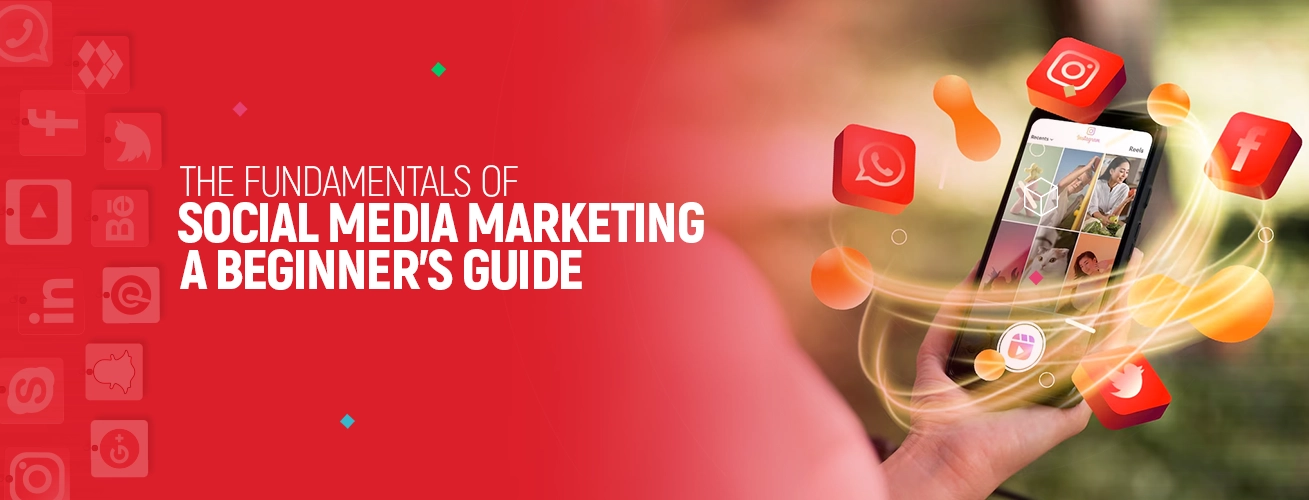The Fundamentals of Social Media Marketing: A Beginner’s Guide
When 4.9 billion people are using social media for entertainment, communication, information exchanges, and online shopping, you cannot simply ignore this vital pillar of any digital marketing campaign. In this age when three-quarters of the world’s population has an active digital footprint on six to seven social media platforms, you must tap this huge audience to meet your marketing goals.
Over the years, social media-based digital marketing has started to play a top-of-funnel role, allowing marketers to enhance brand awareness, strengthen customer engagement, and promote products and services. But you must understand that running a successful social media drive is a complex task, requiring specific skills and expertise. This makes the novice in marketing quite nervous; they cannot understand where to start, which social media platform should be used, and what kinds of tools are available for analytics and reporting. Worry not!
In this article, we will explain everything you need to know to run a result-oriented social media campaign. We will let you know the fundamentals of social media marketing so that you can better design and implement effective social media marketing strategies.
Are you ready to start this exciting journey? Let’s begin with an introduction to social media marketing.
What is Social Media Marketing:
Simply speaking, social media marketing is creating content for social media users so that you can engage them, interact with them, increase brand awareness, promote products and services, and target more and more audiences. Your main objective is to drive traffic to your website and meet all of your marketing goals such as newsletter subscription, increased conversion, reduced cart abandonment rate, and more.
Depending upon the platform the social media marketing firms use to run the marketing drive, various strategies and channels are deployed. Marketers prepare and communicate various messages regularly to build sustained relations with the target audience.
Social media marketing drives can be two types:
First, organic social media marketing involves creating interesting and shareable content to communicate and interact with the audience. It is either free or incurs a very minimum cost.
Second, paid social media marketing entails paid advertisement on various social media platforms. This is deployed to help businesses to acquire a new customer base, reach a specific type of audience, and remarket to ensure an improved conversion rate.
Why Should You Invest in Social Media Marketing?
When there are various types of digital marketing including email marketing, search engine optimization, PPC, and content marketing, to name a few, why should you pay more attention to social media-based digital marketing? We will give an answer to this question by sharing some interesting facts related to social media.
- Social commerce is gaining huge traction. People are purchasing products and services directly from social media. The global market of social commerce is projected to reach $30 billion.
- Social media-based marketing has not only gained popularity among B2C ends, but it is also working wonders for B2B interactions. Studies show that B2B companies are winning on these platforms as well, generating 80% leads from LinkedIn.
- More than 50% of customers expect online businesses to provide customer services through social media platforms.
- On average, every individual uses 7 different social media networking platforms in a month.
- It has been estimated that 200 million social media users visit a business profile every day. What’s more, more than 130 million social media users engage in a shopping post every month, providing ample opportunities to turn them into actual buyers.
- 69% of social media-based marketing experts use these platforms to promote and build brand awareness.
- Total ad spending on social media reached a whopping level of $209 billion in 2022 and is projected to reach $275 by 2027.
- The ad revenue on various social media networks is also showing a continuous upward trajectory. It reached $ 0.95 which is expected to cross $1.42 by 2027.
These statistics clearly show that social media-based marketing drives are providing quick dividends which explains why every business is investing in it. But the question which network you should invest in and why?
Let’s answer this question briefly before we discuss the essentials of social media marketing.
Top Platforms for Social Media Marketing:
Here are some popular social media networks used for digital marketing.
#01: Facebook:
With 2.96 billion active users, Facebook is the most popular social media platform. It is also the most favorite platform as well. There are some 70 million admins and moderators who are running active Facebook groups and pages. What’s more, there are 1.96 billion people worldwide who log in to Facebook daily. People spend on average some 19.6 hours a month on this platform.
This huge number of active users has made Facebook the most preferred choice for social media marketers. It has been reported that 97% of them run Facebook ads to meet specific business and marketing objectives. If you are looking to target a male audience in the age bracket of 25-34 or you want to engage the Indian or US population, Facebook marketing should be your first choice.
#02: Instagram:
Instagram is the second most popular platform after Facebook. It has some 1.38 billion active users that spend a considerable amount of time on this platform. Instagram marketing has gained significant traction over the years because nearly half of Instagram users shop weekly. Similarly, this platform is well-known for driving conversions. This high conversion rate explains that 73% of social media marketing experts use this platform for launching influencer marketing campaigns.
#03: TikTok:
TikTok has left everyone in shock with its skyrocketing popularity. It has now some 1 billion active users, spending 22 hours a month, more than any social media network platform. It has a serious addictive quality that has attracted the attention of brands to launch their marketing campaigns.
Demographically speaking, TikTok is the most popular among the Gen Z population. 30% of Gen Z consumers say that their purchasing decisions are influenced by TikTok-based videos. Therefore, if you are launching a product or service for Gen Z consumers, you should TikTok marketing seriously.
#04: LinkedIn:
Of all the social media platforms, LinkedIn is a unique one. This network has been designed specifically for business discussion and purchasing research. There are over 800 million active users, spending considerable time on various B2B and even B2C activities.
Though LinkedIn is primarily for business life and B2B marketing goals, business-to-consumer brands have found remarkable success on this platform. LinkedIn marketing has been found to offer many eCommerce advantages as well. For instance, it has been estimated that this platform is responsible for 46% of social media traffic to the firm’s website. You can use this platform for promoting products designed for high-earning and educated audiences because more than half of LinkedIn users earn $75,000 and more than 57% are college-educated.
#05: YouTube:
Over the years, YouTube has become the second-largest search engine, accounting for 25% of global mobile traffic. It is also the second most-used social media platform, featuring 14 billion total visits. The total number of active users a day is 122 million and the monthly active user base is 2.6 billion. All these statistics show that YouTube marketing can play a huge role in taping this mouth-watering extensive audience reach.
Besides the above-mentioned platforms, X (formerly Twitter), Snapchat, and Pinterest. These networking platforms provide huge opportunities to sell your products and services. But you must bear in mind that getting started with social media marketing is not an easy job. You need to key principles of social media marketing to meet your stated goals.
Here are some tips and tricks that can help you tap this market and take your brand awareness to the next level. Our social media marketing team has curated these time-tested tactics to keep you ahead of your competitors.
Top Social Media Marketing Strategies for Beginners:
Here are highly recommended tips and tricks to win a social media audience. No matter what you are, a social media marketing firm, an in-house marketing team, or simply trying to promote brand awareness, these social media strategies always work for meeting your marketing goals.
#01: Searching Your Target Audience:
Before you launch your social media marketing drive, it is important to know who you are going to target. This entails performing audience research.
You can start audience research by knowing the demographics of each social media platform. Here are some salient demographics for prominent social media networks.
Facebook Demographics:
Here are must-know demographic facts that marketers need to know:
- Facebook is the most widely used platform in the USA.
- India has the largest number of Facebook users in the world.
- In the USA, Facebook is the least popular platform among Gen Z and millennials, they prefer to use TikTok, Snapchat, and YouTube.
- Teens hailing from low-income groups are found to use Facebook more.
- Women consume more news on Facebook and 56% of Facebook users are male.
Instagram Demographics:
Social media marketers should need to know these interesting demographic facts:
- More than 60% of Instagram users fall in the age bracket of 18-34, more importantly, more than 85% of users are younger than 45.
- Almost 52% of Instagram users identify themselves as male as opposed to 48% who consider themselves as female.
- It has over 2 billion active users, and the overwhelming majority are Indian. The USA has the second-largest regional audience.
- Pew Research shows that 47% of users have an income of more than $75K, and only 30% have an income of less than USD 30,000.
TikTok Demographics:
Here are key facts you need to know as a social media marketing expert.
- TikTok is the #1 downloaded app in more than 40 countries.
- 90% of users say that spending time on TikTok makes them happy.
- 18% of TikTok users are young males aged between 18 and 24.
- 2 of every 3 US teens open TikTok daily, overall, US adults spend over 4 billion minutes every year on TikTok.
- Millennials are most active on this platform, they are 2.3x more likely to promote bands.
#02: Setting Your Marketing Goals and KPIs Clearly:
The second crucial task in implementing a marketing campaign is to set your goals and Key Performance Indicators clearly. You need to make sure that these goals align perfectly with your overall business objectives, visions, and mission.
- First, you need to ask why you are running a campaign. The answer can be multiple such as boosting customer engagement, brand awareness, driving website traffic, generating loads, and more.
- Second, you need to look into specific and actionable steps that can be used to meet these high-level goals. For instance, if you want to drive more traffic to your website through social media-based campaigns, specific actions can be enhanced by posting frequency, creating engaging content, making landing pages more compelling, etc.
- Third, you set Key Performance Indicators or KPIs to measure and track the success of your campaign. KPIs can be various for different business objectives and strategies.
For instance, for brand promotion, KPIs can be followers and shares and for lead generation, possible metrics can be website clicks and email signups.
#03: Determining Your Channel Mix:
Not all social media networking platforms are the same. They have something unique to offer. Therefore, designing a campaign and running all platforms would contribute little to meeting your business objectives. You need to design a campaign that fits perfectly in the unique landscape of every platform.
First, when you perform audience research, you must determine which platform/channel is helping firms attract website and on-page engagement.
Second, you must conduct comprehensive research to learn where your competitors are gaining the most on-page engagement and on which platform they are investing. This will help you use your resources strategically to gain maximum ROI.
Third, look back at all the business objectives you have and check which platform can help you meet them. For instance, if your firm is looking to hire new talent, running a campaign on a visual platform such as Instagram would be a good starter. On the other hand, if you eye on boosting engagement and promoting your brand, Facebook could be the must-have platform for you.
#04: Planning and Scheduling Content in Advance:
Creating and posting compelling content is obviously a key principle of social media marketing. However, you need to make sure that you plan and schedule content in advance. You can ill afford to disrupt your workflow during the day or night to share content on the platform. The planning in advance allows you to run a marketing drive that is consistent across various channels.
You take the help of available tools in this regard. For instance, any social media marketing dashboard like Hootsuite helps you create content and schedule your posts to give live on the right channel and at the right time. Furthermore, Hootsuite allows you to keep a bird’s eye view of your content and keep tracking performance against set KPIs.
#05: Creating Compelling and Engaging Content:
Needless to say, when there are over 4.9 billion social media users, your content needs to stand out. You must convince your target audience to do your desired tasks: subscriptions, following, shares, likes, and comments.
If your followers start engaging with you regularly, the social media algorithm begins prioritizing your content. This is a very simple trick, but the question is how to write engaging content that is captivating and memorable.
First, you look into consumer and demographic trends. Here are some hard facts you need to know in this regard.
- The most engaging content is visual content. Consumers spend more time with such content. For instance, 53% of the time is spent on images/infographics/images. Similarly, short-form video is a popular type of content, attracting 44% of time spent on social media.
- Short-form video is the most popular among Millennials.
- Boomers enjoy images and infographics whereas Gen X, Gen X, and Millennials love to spend time on video content.
- Funny content is the most memorable for Gen Z and Millennials.
Second, besides these demographic trends, you need to look into the strategy of your competitors. You must search for what type of content they are using to promote their products and services on various social media networks.
Third, User Generated Content, or UG has become the most potent source to lure your target audience. You can repost the comments and reviews made by your customers. Furthermore, you can ask them to use the hashtag and share their experience.
Lastly, joining a trend can give you a huge boost in your reach. The trends emerge frequently on short-form social media platforms such as TikTok and Instagram. The key to success is time, the earlier you join the trend, the better.
Finally, Monitoring & Adjusting Your Campaign:
Last but not least, you must keep in mind that social media is fast evolving, there are always new updates and continuous emergence of new features. What’s more, user behavior is also changing in response to the emergence of new technologies and enhancing the capabilities of devices. Therefore, you need to keep monitoring the progress and evaluating them against the benchmarks you have set.
Wrapping Up:
Social media is part and parcel of our lives. It has penetrated deeply into our lives, impacting our cognitive, emotional, and psychological responses. This immense power of social media to influence our decision-making has led to the emergence of social media marketing. The SMM has become a key pillar of digital marketing. It has many advantages in comparison with other digital advertising such as readily available access to a wider audience, the ability to track and monitor marketing campaigns, cost-effectiveness, and organic traffic. In this background, we have compiled the fundamentals of social media marketing so that you design and implement a result-oriented drive to boost your customer engagement, drive website traffic, generate leads, communicate with your customers, build your trust, enhance sales, and establish your online presence. We do hope that these tips and tricks will help you turn your business objectives into a living reality.
Thanks for your reading. Your feedback would be deeply appreciated.




